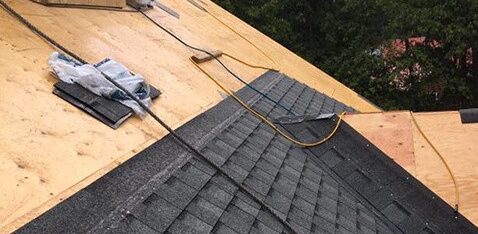Roofing Felt: Why Should You Install Roofing Felt?

You already know how important your roofing system is to your home. You don’t need to be an expert in roofing to know this. Your roof protects you from the elements. That is basically all we know, and it’s okay. But have you ever wondered what goes into the whole roofing system?
Maybe you think you already enough about the roofing materials needed to have a full roofing system. Surprisingly, there’s more that’s goes into having a complete roof. Beyond the shingles, nails, and eaves, much more go into having a secure roofing system.
And then, there’s the roofing felt. Maybe you’ve heard about it. But have you ever wondered if it’s really necessary to install one? We will address this question and much more to help you understand the role of roofing felt for your home.
What Is Roofing Felt?
To form an effective barrier from the elements, a layer of roofing felt must be installed in your roofing system. So what exactly is it?
Roofing felt is a waterproof barrier material installed directly just on your roof deck and acts as an extra layer of protection from severe weather. Put simply, roofing felt is a form of insulation that is put in place to keep moisture from seeping into your home.
There are sometimes called roll roofing, roofing tar paper, or underlayment. This extra layer of protection from the outer element is installed between the roof deck and the roofing shingles. It usually comprises a base made from natural materials like wood cellulose and sometimes synthetic materials like fiberglass or polyester. It is then coated or reinforced with a protective coating like bitumen to make them more water-resistant.
Tar paper usually lies between your house and the final layer of your roofing material. It provides a comfy barrier for wood sheathing from the elements, including ferocious downpours of rain and heavy snow.
What Are The Types Of Roofing Felt?
Roofing underlayment falls into three main categories;
- Asphalt-saturated felt
- Non-bitumen synthetic underlayment
- Rubberized asphalt underlayment
While the asphalt-saturated felt and the non-bitumen synthetic underlayment are water-resistant, the rubberized asphalt underlayment is waterproof. Made from different blends of cellulose (natural plant fibers), polyester, bitumen, or asphalt, the asphalt-saturated felt used to be the most applied type of roofing felt until recently.
For several reasons, the synthetic underlayment is now the most preferred underlayment by most professional roofers. It is more stable and very resistant to tear, thanks to the addition of fiberglass. And finally, the rubberized asphalt. However, it contains higher percentages of asphalt and rubber polymers, making it more expensive than other types of roofing felt.
Why Do You Need A Roof Felt?
Adding an extra layer of protection between your home and your roof shingles can help you get a more aesthetically appealing roof that can stand the test of time. There is so much to gain from installing a roof felt. Some of these exciting positives include;
- It Keeps Your Roof Waterproofed
Your roofing felt will always step up when it seems that your shingles are giving up. Snows, and ice, once they thaw, can always find their way to get under your shingles. This can expose your roof deck to dangers from water damage, leaks, rot, and mold. Well-installed roofing felt can help you keep the water away from your home.
- Protects Your Home From Dangers Of Ice Or Water Damage
Try as much as you may; sometimes, you can’t possibly stop ice dams, but you can always control the impact. All it takes is an effective water protection membrane. Roofing felt offers an extra layer of protection against water leakage that could cause damage to your ceilings, walls, or insulation.
- It Offers Extra Protection From The Elements
Your shingles are always your roof’s first line of defense from the elements. They reflect UV rays, withstand strong winds, and even help in the fight against ice dams. But sometimes, this first line of defense can throw in the towel. After facing these relentless elements, the shingles become weak and give way to leaks. At this moment, having a backup layer of protection can be your home’s Messiah. A roof felt can help extend the life of your roof deck. It can protect your roof deck until you fix your shingles.
- Protect Your Roof Deck Even As You Work On It
Your roof felt, or underlayment offers so much protection to your roof deck. The roofing felt guards your wood deck against the elements like rain and water, even as you’re working on applying the shingles and after you’ve used the shingles.
- It Improves Roof Aesthetics And Uniformity
Roof decks are not always laid perfectly. Appling roof tar paper gives your roof a more even and a uniform surface where you can install your shingles. Aside from creating a more even roof surface, having a roof felt as part of your general roofing system can increase the value of your home.
Bottom Line
Installing roofing felt, underlayment, roll roofing, or tar paper roofing is more than just necessary; it’s essential!
Whether you have an asphalt roof or any flat roof, be it a residential or commercial structure, you’ll always need an extra layer of protection. Call it a backup plan for your shingles. You need a roof felt to give the top of your structure extra protection against the elements.
Also, ensure that you chose underlayments that are approved and are exceptionally agreeable with the overlying shingles. They should always comply with the building codes. Ensure that they all meet up to the ASTM International standards.
Above all, hiring professionals to take care of your roofing needs, including the installation of roofing felt, can always make a whole lot of difference. When it’s time for you to get a roof underlayment, wouldn’t you want to get the best value for your money? Contact us Royal Renovators at 118-35 Queens Blvd Forest Hills, NY 11375 (718) 414-6067, https://www.nycrenovators.com, for the best roofing services in NYC.
